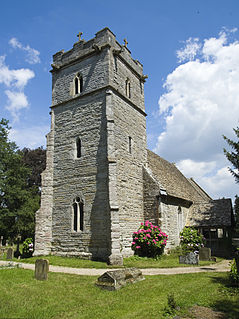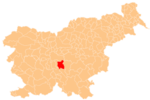
Grosuplje is a town in central Slovenia. It is the seat of the Municipality of Grosuplje. It lies just south of the capital Ljubljana in the traditional region of Lower Carniola. It is now included in the Central Slovenia Statistical Region.

Moravče is a settlement in the Municipality of Moravče in central Slovenia. Traditionally the area was part of the Upper Carniola region. The village is home to about 925 people. It includes the hamlet of Trzen.

Stopiče is a village in the foothills of the Gorjanci range in the Municipality of Novo Mesto in southeastern Slovenia. The area is part of the traditional region of Lower Carniola and is now included in the Southeast Slovenia Statistical Region.

Javorje is a village in the hills between the Selca Sora and the Poljane Sora valleys in the Municipality of Gorenja Vas–Poljane in the Upper Carniola region of Slovenia.
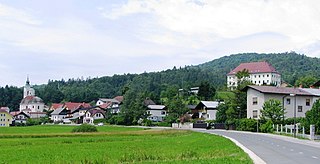
Dobrova is a clustered settlement northwest of Ljubljana in the Upper Carniola region of Slovenia. It is the administrative centre of the Municipality of Dobrova–Polhov Gradec. It lies on the road from Ljubljana to Polhov Gradec at the point where roads split off to Horjul to the southwest and to Šentvid, Ljubljana to the northeast. It extends along the flat area to the northeast up to the Gradaščica River and encompasses much of Dobrova Hill to the southwest. Bezenica Creek, Broad Creek, and Ječnik Creek, left tributaries of the Horjulščica River, flow through the hills west of the settlement. Dobrova includes the hamlets of Pod Kotom northwest of the main settlement and Graben southwest of the main settlement.

Janče is a dispersed settlement in the hills south of the Sava River east of the capital Ljubljana in central Slovenia. It belongs to the City Municipality of Ljubljana. It was part of the traditional region of Lower Carniola and is now included with the rest of the municipality in the Central Slovenia Statistical Region.
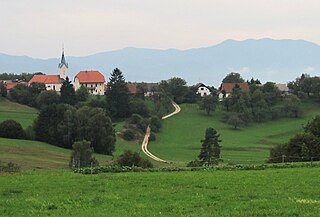
Mali Lipoglav is a settlement in central Slovenia. It lies in the hills southeast of the capital Ljubljana and belongs to the City Municipality of Ljubljana. It was part of the traditional region of Lower Carniola and is now included with the rest of the municipality in the Central Slovenia Statistical Region.

Rašica is a small village in the hills above Srednje Gameljne north of the capital Ljubljana in central Slovenia. It belongs to the City Municipality of Ljubljana. It was part of the traditional region of Upper Carniola and is now included with the rest of the municipality in the Central Slovenia Statistical Region.

Videm is a village in the Municipality of Dobrepolje in Slovenia. It is the administrative centre of the municipality. The area is part of the historical region of Lower Carniola. The municipality is now included in the Central Slovenia Statistical Region. Videm consists of two hamlets: Mali Videm is the core of the settlement around Holy Cross Church, and Veliki Videm is located to the northwest, along the road toward Predstruge.

Podgora is a village in the Municipality of Dobrepolje in Slovenia. The area is part of the historical region of Lower Carniola. The municipality is now included in the Central Slovenia Statistical Region.
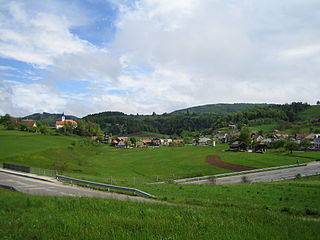
Polica is a settlement in the Municipality of Grosuplje in central Slovenia. The area is part of the historical region of Lower Carniola. The municipality is now included in the Central Slovenia Statistical Region. Polica includes the hamlets of Bliska Vas, Žabja Vas, Hrib, and Goričane.

Čušperk is a village in the Municipality of Grosuplje in central Slovenia. It lies in the hills south of Grosuplje in the historical region of Lower Carniola. The municipality is now included in the Central Slovenia Statistical Region.
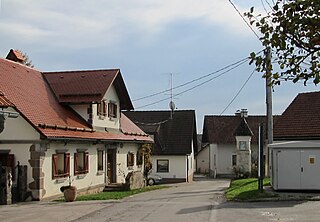
Zgornja Slivnica is a settlement in the Municipality of Grosuplje in central Slovenia. It lies in the hills north of Grosuplje and northeast of Šmarje-Sap and south of Mali Lipoglav in the historical region of Lower Carniola. The municipality is now included in the Central Slovenia Statistical Region.

Tlake is a settlement in the Municipality of Grosuplje in central Slovenia. It lies west of Šmarje–Sap on the road to Škofljica. The area is part of the historical region of Lower Carniola. The municipality is now included in the Central Slovenia Statistical Region. The settlement consists of two parts: Spodnje Tlake and Zgornje Tlake.

Polje pri Višnji Gori is a settlement southeast of Višnja Gora in the historical Lower Carniola region in central Slovenia. It belongs to the Municipality of Ivančna Gorica, which is included in the Central Slovenia Statistical Region.

Žirovnica is a settlement in northwestern Slovenia, in the Municipality of Žirovnica. It is located in the historic Upper Carniola region, on the southern slope of the Karavanks mountain range, close to the border with Austria.

Jerova Vas is a formerly independent settlement in the northern part of the town of Grosuplje in central Slovenia. It belongs to the Municipality of Grosuplje. It was part of the traditional region of Lower Carniola and is now included with the rest of the municipality in the Central Slovenia Statistical Region.

The Račna Karst Field is a karst field in the northern edge of the Lower Carniolan karst area, south of Grosuplje, Slovenia. It has rich natural and cultural value. Because of its ecological significance, it is anticipated that a nature park will be established there and that it will be included in the Natura 2000 program.
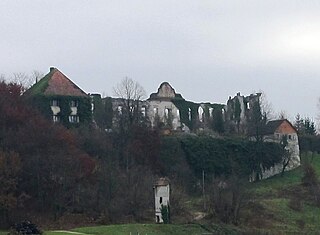
Boštanj is a formerly independent settlement in the southern part of the village of Veliko Mlačevo in central Slovenia. It belongs to the Municipality of Grosuplje. It was part of the traditional region of Lower Carniola and is now included with the rest of the municipality in the Central Slovenia Statistical Region.








